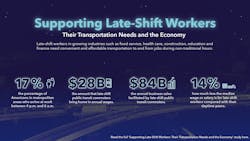APTA study: Additional transit services are needed for late-shift commuters
The American Public Transportation Association (APTA) released a study highlighting the needs of late-shift commuters, their growing impact on the economy and recommendations to improve commuting options.
The “Supporting Late-Shift Workers: Their Transportation Needs and the Economy” study, shows a large share of Americans work nights and weekends within industries such as food service, health care, construction, education and finance. These industries have high projected growth rates over the next seven years, but inadequate access to public transit services can prevent segments of the workforce from accessing better job opportunities while also increasing turnover and absenteeism rates for employers.
Many public transit agencies around the country operate late shift services but additional services are vitally needed, according to the study. Late-shift transit commuters earn an estimated $28 billion in wages and generate $84 billion in sales each year. Increased late-night transit options will result in access to opportunities for late-shift employees and increase the pool of workers for employers.
Late-shift workers in Metropolitan Statistical Areas (MSAs) are 40 percent less likely to commute via public transit due to inadequate service. Many are much more likely to take on the cost burden of operating personal vehicles or utilizing rideshare services like Uber and Lyft. Transit operators, along with business and political decision-makers, have an opportunity to remedy this issue.
“The late-shift is a growing source of opportunity for the American economy. When public transit providers, private sector businesses and policymakers work together, late-shift transportation can be improved through increased funding, new public policy and innovative service,” said APTA President and CEO Paul P. Skoutelas.
Public transit providers face several challenges to running late-night service. This study showcases examples in Las Vegas, Nev., Pittsburgh, Pa., Los Angeles, Calif., Detroit, Mich., Battle Creek, Mich., Boston, Mass., and North Kingstown, RI., outlining innovative ways transit operators can address issues like maintenance, operating costs, service planning and more in order to expand existing systems and create new ones.
“More and more often, we are hearing from our area’s largest employers — hospitals, financial institutions and companies that have employees who don’t work the usual 9-to-5 — about the need for access to high-quality, around-the-clock transit service,” said Katharine Kelleman, CEO of Port Authority of Allegheny County. “Late-night or 24-hour service would drastically improve their ability to recruit and retain employees and allow us to offer more robust transportation options to all of our customers throughout the Pittsburgh region.”
“Detroiters are on the go, around the clock,” said Mark de la Vergne, chief of mobility innovation for the Mayor’s Office of Detroit. “Adding 24-hour service to twelve core routes of [Detroit Department of Transportation’s] network and piloting an innovative option like Night Shift demonstrates our ongoing commitment to addressing all of our customers’ needs.”
Some of the study’s proposed solutions for transit operators, business owners and policymakers include:
• Extend spans of service. Transit operators can make existing services more convenient and flexible by increasing operating hours.
• Establish programs dedicated to funding late-shift transit operations. Without new funding at the state and federal level, transit agencies are limited in their ability to expand services.
• Increase investment in transit system state-of-good-repair and shrink the backlog of deferred maintenance. Overall investment in transit infrastructure gives agencies more flexibility in their hours of service.
• Embrace innovative partnerships to meet late-shift mobility needs. Ride-matching services offer guaranteed rides home where fixed-route public transit might not be appropriate or attainable.
• Formalize frameworks to allow employers that benefit most to subsidize late-shift transportation. Create a standardized process for partnerships between transit agencies and the private sector will allow both to pool necessary resources to promote late-shift ridership and invest in more impactful public transit service.
“As we continue to upgrade and modernize our public transit systems with an eye to the future, we can’t afford to leave behind one of America’s fastest growing areas of the workforce,” said Skoutelas. “Innovation will drive new partnerships, and increased infrastructure investment will see public transit systems leading the way with increased ridership and enhanced operations during the late-shift, as well as during more traditional hours.”
The full study can be read here.

